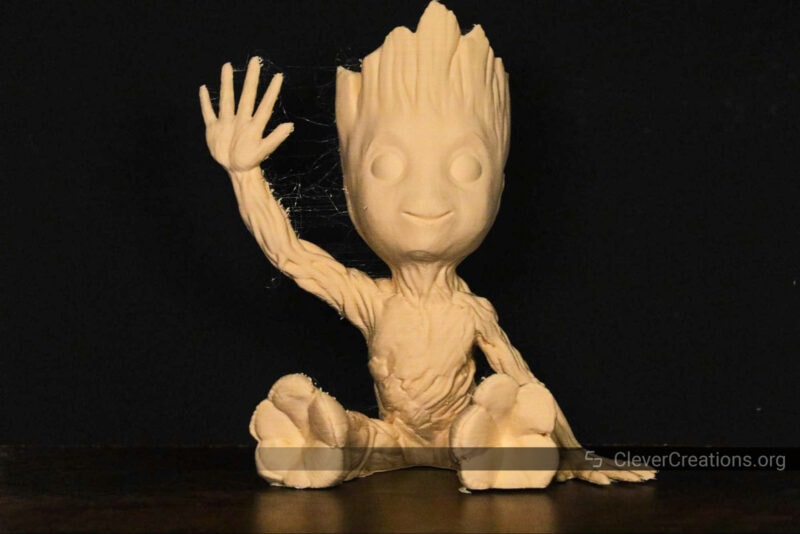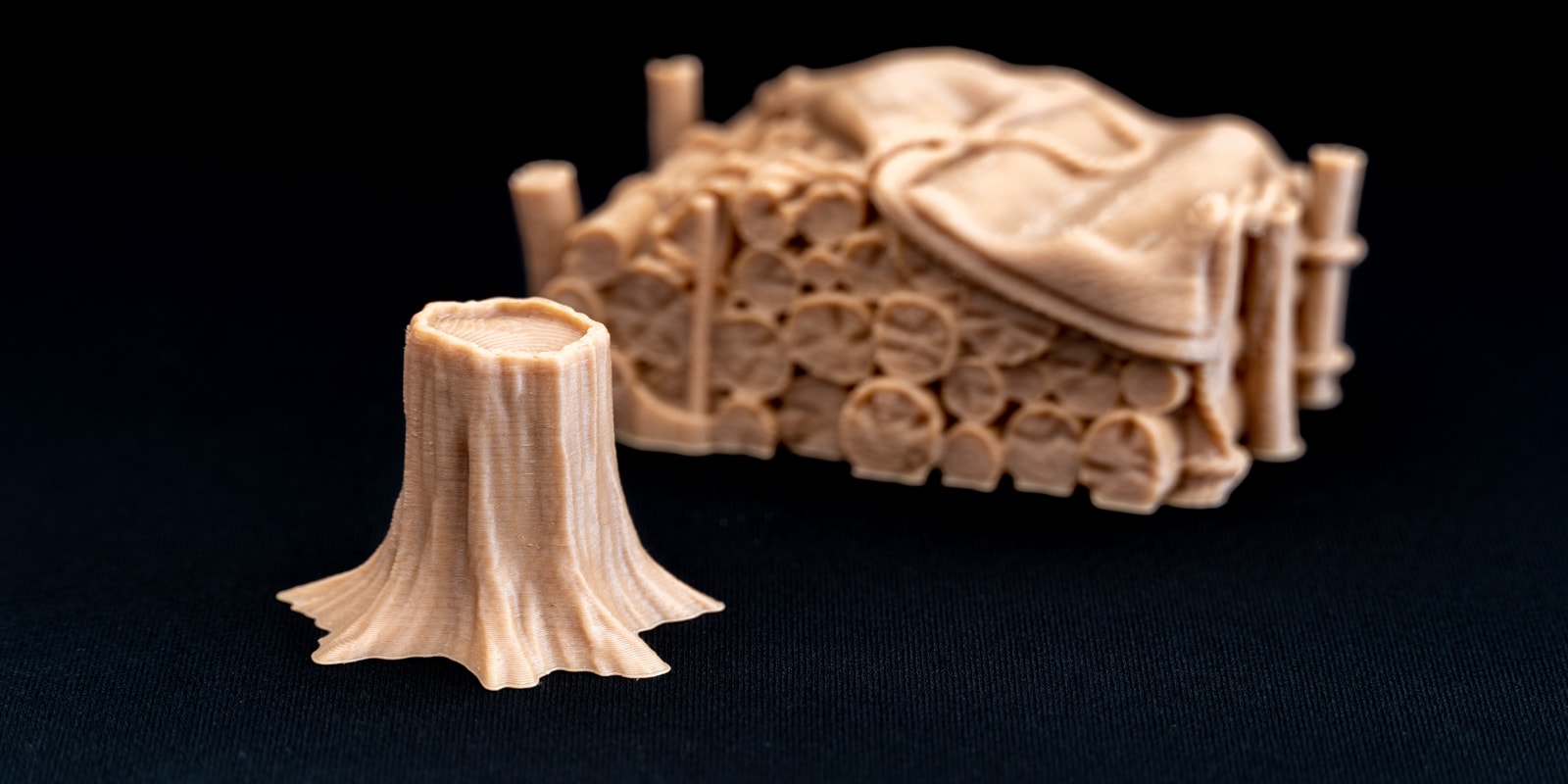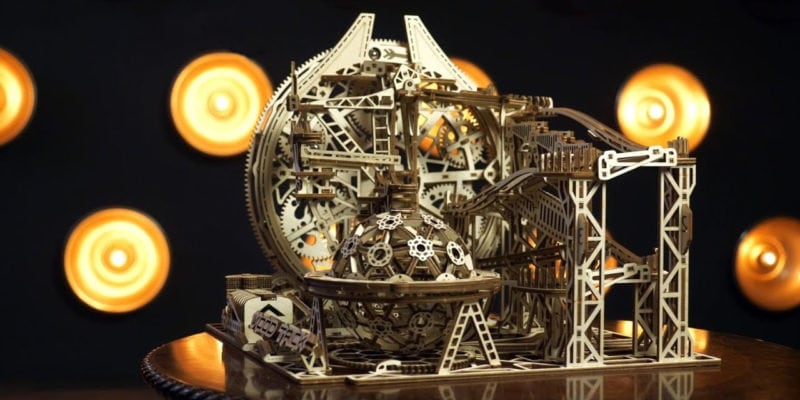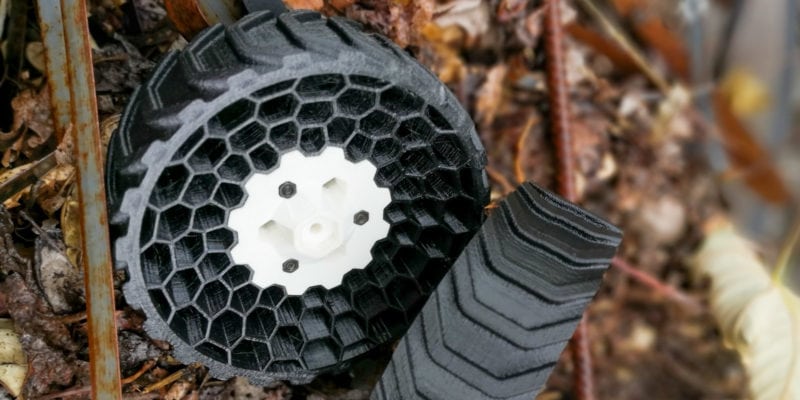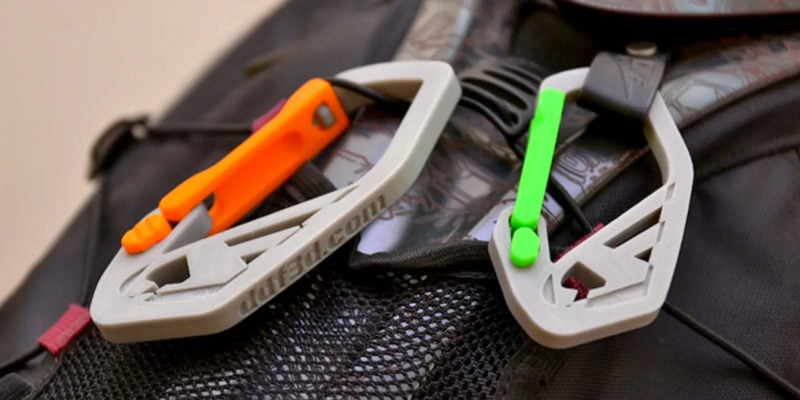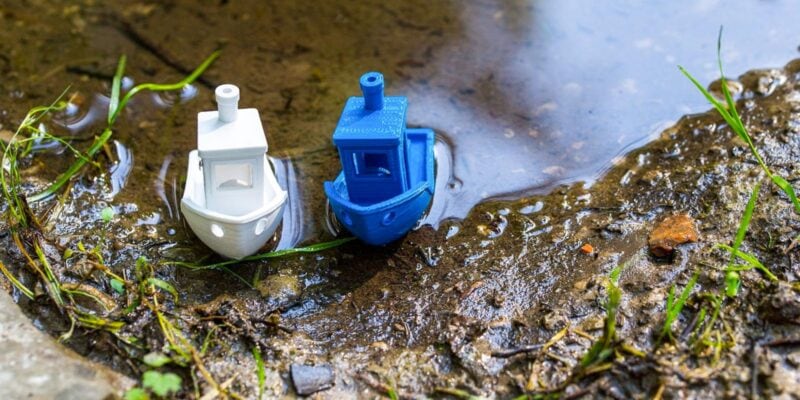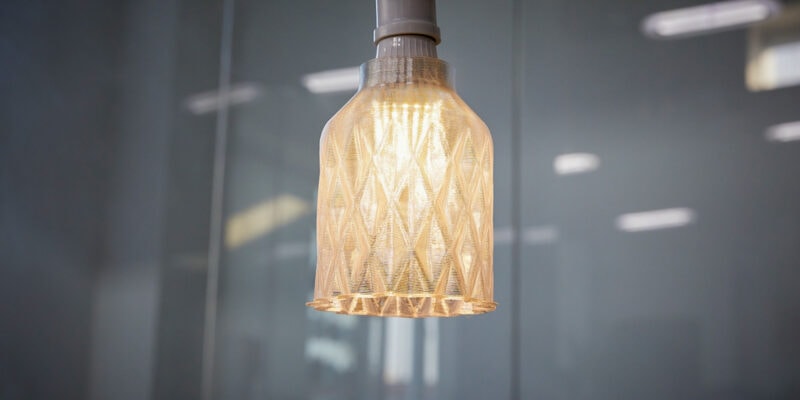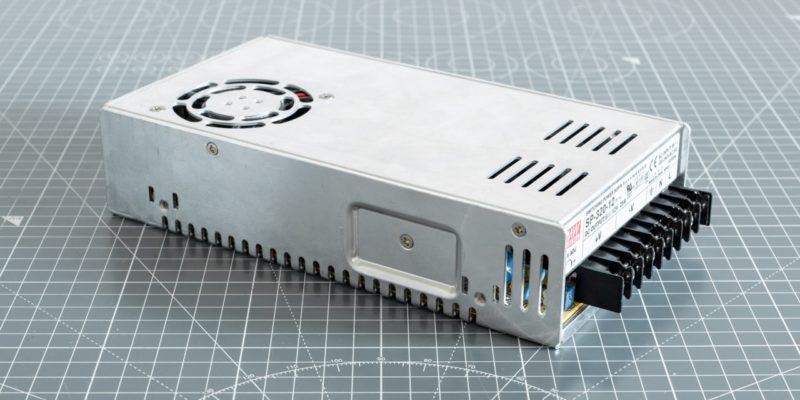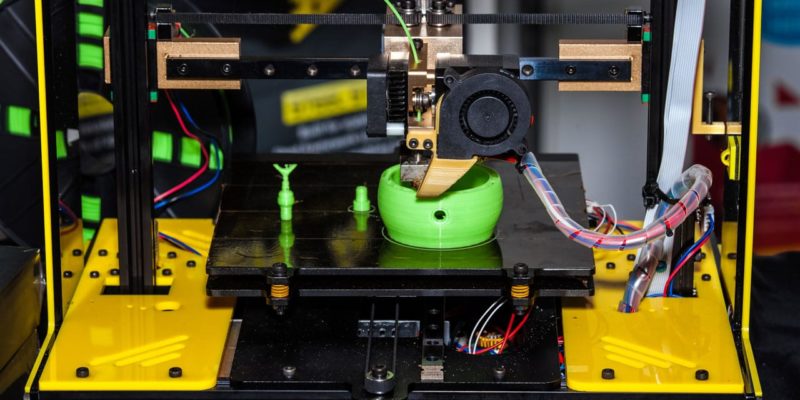Prior to 2012, 3D printing wood on hobbyist 3D printers was a distant concept. Kai Parthy changed this notion by developing the first ever wood 3D printing filament in 2012 by mixing PLA with real wood fibers.
Manufacturers quickly jumped on this idea and released their own versions of wood filaments. Today, you’ll find multiple wood filaments that have a strikingly similar appearance and surface finish to real woods. Walnut, bamboo, birch, cedar, pine, rosewood, cork, you name it.
Yet, as a 3D printing material, wood is still a niche filament with its own peculiar challenges. This article aims to demystify wood filament and help you understand everything there is to learn about it.
After reading, you’ll have a complete know-how of this filament and have the confidence to 3D print some fantastic wooden models.
Let’s embark on our wood journey!
What is Wood Filament?

Wood filament is a blend of wood particles mixed with filament. You’ll find wood fibers, sawdust, and other wood composites blended with PLA polymers (or a different biodegradable base) to create wood filaments for 3D printing.
Each manufacturer uses different kinds of wood material mixed in various ratios with 3D printing filament. It allows for multiple variations of wood filament in different colors, textures, material characteristics, and even smell. You can take a look at just the range of options in Fillamentum’s TimberFill line to get an idea of what is possible.
In some cases, manufacturers skip using wood and use special Polymers to mimic the appearance of wood.
For instance, Polymaker Polywood does not contain any actual wood. Instead, it’s a unique PLA polymer blend that replicates the texture, appearance, and color of wood filament.
Because of its PLA polymers, wood filament is closest to PLA filament. The main differences are the texture and post-processing abilities. Like actual wood, wooden 3D prints stain well, adhere to paint, and are easily sanded.
What Should You Use Wood Filament For?
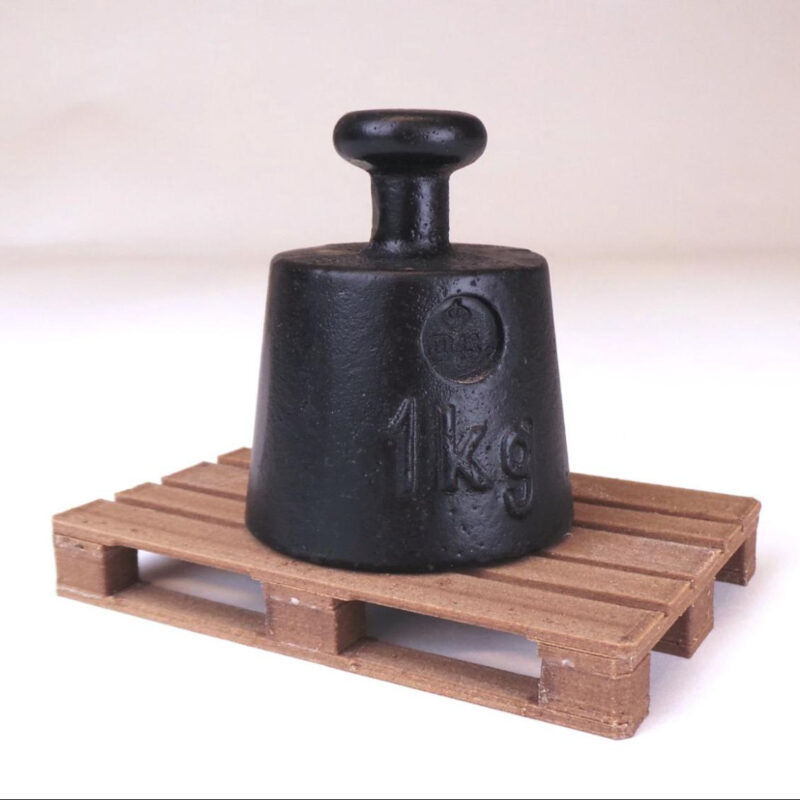
Wood PLA filament is excellent for printing decorative items, art pieces, and aesthetic models that can benefit from the properties of wood material. Baby Groot is one of the most 3D-printed models in the wood filament, primarily because of the appearance of its character in the movie.
Likewise, you can 3D print things like enclosures, trays, coasters, and jewelry boxes, all of which look amazing when printed with wood filament. Alternatively, you can pick up any figurine or model and 3D print it with wood PLA filament to get a wooden appearance.
You should, however, not 3D print functional or load-bearing components with wood filaments.
As wood fibers are mixed in between PLA plastic, the density of this filament is less than that of even regular PLA, and it’s not a structurally strong 3D printing material.
So while you can print small shelves, hinges, and mobile/tablet holders, items like functional gears, mounts for heavy items, and parts for 3D printers are off-limits.
All-in-all, wood filament is a versatile material for 3D printing. You can even mimic the pattern of real wood in your 3D prints by varying the printing temperature. We’ve included some valuable tips and tricks further below that’ll help you to get the best results with wood filament.
Advantages and Disadvantages
Advantages
Easy to 3D Print
Wood filament is more forgiving compared to most other 3D printing materials. It prints at the similar temperatures as PLA filament and you can print it without a heated bed. The warp and layer splitting issues are also minimal in wood PLA filament, so you don’t need a 3D printer enclosure to print it.
Excellent Surface Finish and Texture
Wood filament lends a good surface finish to your printed models, similar to actual wood material. Certain filament manufacturers also let you choose between filament textures. Depending on the texture, you can get a coarse or smooth texture for your 3D printed models.
Post-Processing Flexibility
Like natural wood, you can sand and polish your wood 3D prints using sandpaper. It enhances the surface finish of your models while making them appear more like actual wooden objects.
Certain wood filaments like Hatchbox’s wood PLA react well to staining. This can help protect your 3D printed wooden models, bring out their wood texture, and even give an aged look to them.
Disadvantages
Retraction and Stringing Issues
Wood filament is more prone to excessive stringing and oozing than other filaments. As a result, it can take a good amount of time to fine-tune the retraction settings for this material.
Excessive retraction with wood filament can cause your hot end to jam, and little retraction will keep the material oozing between travel moves. So it’s important to find the right balance.
Nozzle Clogging
Most wood filaments contain small bits of wooden material mixed with PLA plastic material. These small bits can create nozzle clogging in smaller 3D printer nozzles and lead to under extrusion issues in your prints.
Hence, when printing with wood filament, it’s always recommended to use a nozzle size larger than 0.5 mm. Smaller nozzles don’t do well with the relatively large wood fibers, whereas larger nozzles do.
Nozzle Wear
Aside from the wood fibers causing nozzle clogging, they can also be abrasive. Over time, this can cause wear and tear on your 3D printer’s nozzle. It’s recommended to use a hardened steel or nozzle specially designed for abrasive materials to avoid having to swap your plain brass nozzle regularly .
Needs Post-Processing
3D-printed wood models often have a coarse texture and you might want to refine them after 3D printing. Sanding, polishing, painting, you can do it all. But you’ll have to keep in mind that this increases the post-processing time of your 3D prints.
Wood PLA Print Settings
In the table below you can find the recommended slicer settings for wood filaments. These are not absolute parameters, but something that will give you a head start when 3D printing wood material.
| Recommended Wood PLA Filament Settings | |
|---|---|
| Printing Temperature | 180 – 220 °C |
| Heated Bed Temperature | 45 – 60 °C |
| Bed Adhesion | Blue Tape, Glue Stick, Glass Plate, PEI, PC |
| Print speed | 40 – 60 mm/s |
| Nozzle size | 0.5 mm or larger |
You’ll also need to dial in the slicer settings for retraction when 3D printing wood filaments. Regardless of whether you use a Bowden or Direct drive extruder, a good rule of thumb is to increase your retraction distance by 1-3 mm compared to regular PLA material.
If you live near a beach or in a high-humidity area, it’s also recommended to dry the filament before printing it. You can use a filament dryer or food dehydrator to remove moisture from the wood filament. For most types of wood filament, drying at 55˚C for 6 hours is enough to let you print free of the popping, hissing, or excess stringing caused by wet filament.
Lastly, most wood filaments change their final color depending on the temperature you print them at. It prints lighter at lower nozzle temperature settings and shifts to a darker shade at higher temperatures.
It’s an important thing to consider as the print temperature can affect the final shade of your wood 3D print. While you could see this variation as a downside, it’s actually a benefit that you can play around with. For example, by using different temperatures when 3D printing the wooden object, you can create colored lines that mimic real wood.
Now that we have a brief overview of wood as a 3D printing material, let’s take a look at some of the best wood filaments you can use to 3D print high-quality wood models.
The Best Wood Filament in 2024
SUNLU Wood PLA
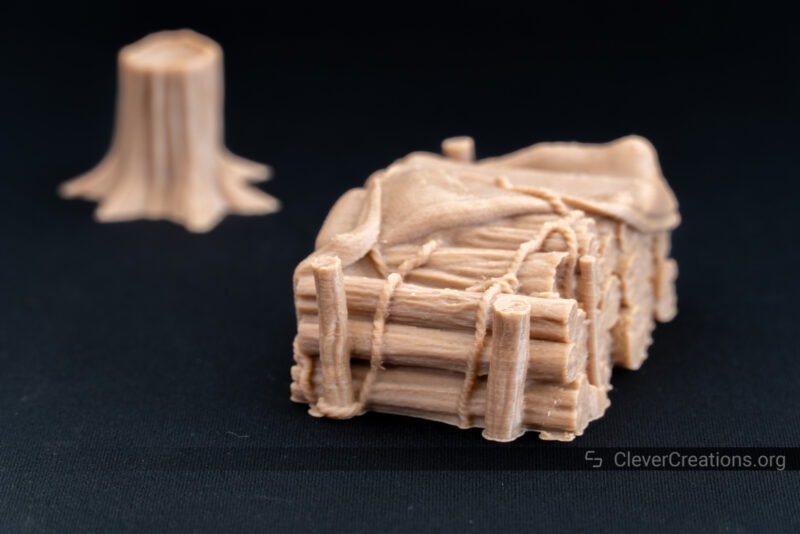
SUNLU wood filament is one of the most affordable wood filaments in the market right now. It is listed as having an excellent dimensional accuracy of ±0.02 mm and is easy to print.
The filament has a real wood-like appearance and a smooth surface finish. The finished models come out with a satin-smooth finish, almost like your normal PLA plastic for 3D printing. Nonetheless, the prints with this material are easy to post-process and respond well to sanding and staining.
Some users have noticed a weak layer bond with this filament; however, we have found you can avoid this issue by 3D printing at higher temperatures and slower print speeds. It allows the material to extrude nicely and bond well to the previous layers of 3D printed wood.
SUNLU wood PLA filament is a great budget option for beginners and first-time wood material users. It’s a good wood filament for basic hobby purposes and provides good value for its price.
| SUNLU Wood PLA | |
|---|---|
| Color | Wood |
| Nozzle Temperature | 190-220 °C |
| Printing Speed | 50-100 mm/s |
| Bed Temperature | No need or 60 – 80 °C |
| Filament Diameter | 1.75 mm |
Polymaker PolyWood

Typically, you’ll find wood filaments made of a blend of PLA mixed with wood fibers or sawdust. However, with its PolyWood filament, Polymaker has taken a different approach and developed a wood-like material of 100% PLA.
PolyWood is a unique blend of PLA polymers that give the material a wood-like appearance and surface finish. It uses Polymaker’s proprietary Stabilized Foaming technology that reduces the density of the material while making it easy to 3D print.
The layer lines on the printed models are very well hidden, and you get a nice matte surface finish on your prints. The only catch is as the filament is pure PLA, and sandpaper polishing doesn’t work well with it.
Otherwise, PolyWood is one of the best wood filaments if you need the aesthetics of wood material without its 3D printing difficulties.
| Polymaker Polywood | |
|---|---|
| Color | Wood |
| Nozzle Temperature | 190-210 °C |
| Printing Speed | 30-50 mm/s |
| Bed Temperature | 25-60 °C |
| Filament Diameters | 1.75, 2.85 mm |
AMOLEN Wood Filament

AMOLEN wood filament is a blend of 20% real wood powder mixed with PLA material. The resulting material is similar to actual wood with a matte texture and slightly coarse surface finish.
As it contains real wood fibers, you can polish your 3D prints, and the material also stains very well, giving your object an authentic wood-like feel. It’s excellent for 3D printing decorative and functional models like wood frames, signs, trays, and coasters, which would look great with a stained finish.
The material prints similarly to your regular PLA material, and you can get away without calibrating your print temperatures. However, it would be helpful to fine-tune your retraction settings and use a 0.5/0.6 mm nozzle to avoid unnecessary clogging issues.
Overall, AMOLEN’s wood PLA filament is an excellent and easy-to-print material, best suited for beginners and hobbyists who can benefit from high-quality wooden 3D prints.
| AMOLEN Wood Filament | |
|---|---|
| Color | Wood, Dark Wood Walnut, Red Wood, Ebony Wood |
| Printing Temperature | 190-220 °C |
| Printing Speed | 50-90 mm/s |
| Heated Bed Temperature | 25-60 °C |
| Filament Diameter | 1.75 mm |
Hatchbox Wood PLA
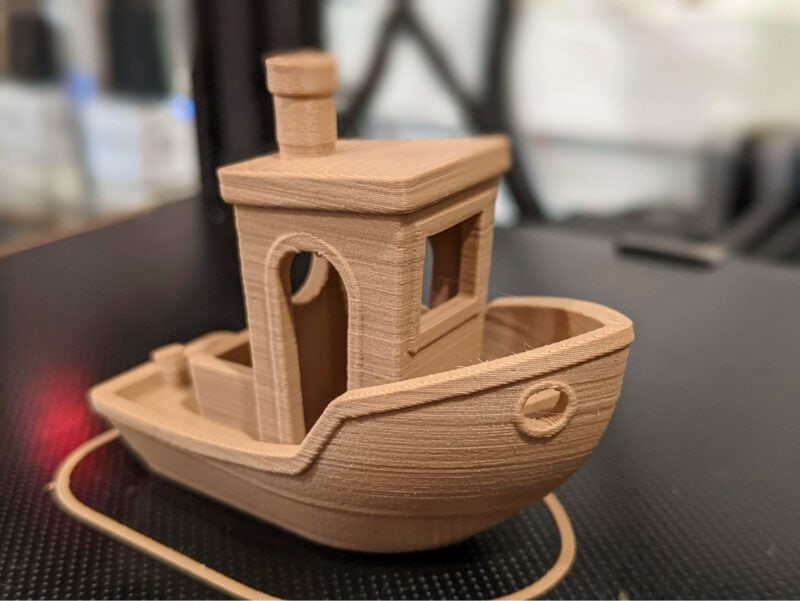
Hatchbox filaments are known for their easy printability and quality, and Hatchbox Wood PLA is no exception.
It’s easily accessible to 3D print, results in a smooth surface finish, and stains beautifully to give your models a natural wood-like appearance. The filament is odorless, and you can print it without a heated print bed with minimal adhesion.
The reviews on the Hatchbox wood are primarily positive, with most users claiming good printability and almost no visible layer lines. You can buy this filament in three colors – Regular wood, Black Wood, and Dark Brown Wood.
For $31.00, the Hatchbox Wood PLA filament is reasonably priced and provides excellent value compared to its competitors. With a little fine-tuning, you can get great results and items that closely resemble actual wood material.
| Hatchbox Wood PLA | |
|---|---|
| Color | Wood, Black Wood, Dark Brown Wood |
| Nozzle Temperature | 175-220 °C |
| Printing Speed | 40-60 mm/s |
| Bed Temperature | No need or 60-80 °C |
| Filament Diameter | 1.75, 3.00 mm |
What Kind of 3D Printer Do You Need for Wood Filament?
Wood filament is a relatively easy material to 3D print, and you can print it on most modern 3D printers. Some wood filaments you can even print on 3D printers without a heated bed, further lowering the entry point to wood 3D printing.
Although a direct extruder and a heated bed help with retraction and bed adhesion, having these components is optional. They will give you a much easier time however.
We have 3D printed wood filament successfully on machines as old as a first-generation Ender 3 with an almost stock configuration. But we continue 3D printing with it regularly in our 3D printer reviews. It’s a fun filament to test and print with much variety between types and manufacturers.
Wood Filament Demonstration
To give you a quick demonstration of wood filament, we printed a few models with ESUN Wood PLA filament on a first-generation Ender 3 3D printer. We tweaked a few settings from the default recommendations. All images were taken before any post-processing of the models.
Temperature Tower

| Model | Smart Temperature Calibration Tower |
| Layer Height | 0.2 mm |
| Print Speed | 40 mm/s |
| Hotend Temperature | 195-235 °C |
| Bed Temperature | 60 mm/s |
| Retraction | 7 mm |
It’s helpful to determine the correct printing temperatures for the filament before printing detailed models. The temperature tower test helps you examine the temperature, retraction, bridge, and overhang settings in a single print.
At higher temperatures, the material tends to sag due to insufficient cooling. The stringing, too, is more evident above 220 °C. The optimal temperature for this filament is between 210 – 215 °C, with slightly higher retraction settings.
One thing to note is that this particular ESUN wood PLA filament doesn’t change color when temperatures change.
3D Benchy

| Model | 3D Benchy |
| Layer Height | 0.2 mm |
| Print Speed | 40 mm/s |
| Hotend Temperature | 215 °C |
| Bed Temperature | 60 °C |
| Retraction | 8.5 mm |
The 3D Benchy came out surprisingly well for the test prints. There are a few strings present in the model, but the overhangs were printed nicely. The layer lines also blend in nicely and give the model a clean look. The retraction settings and the temperature are dialed in near-perfect.
Baby Groot
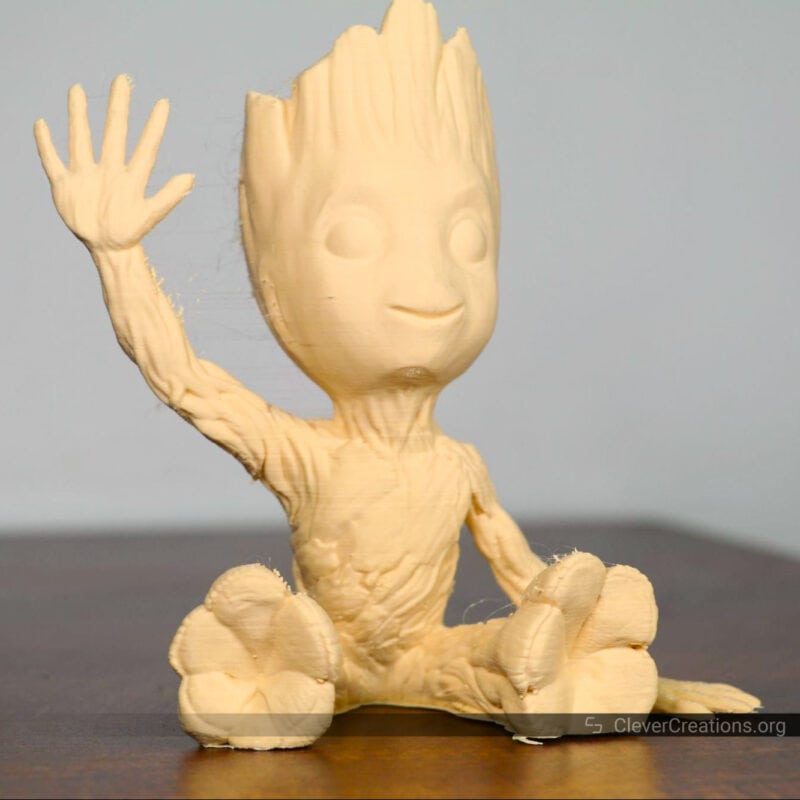
| Model | Baby Groot Hollow |
| Layer Height | 0.2 mm |
| Print Speed | 40 mm/s |
| Hotend Temperature | 215 °C |
| Bed Temperature | 60 °C |
| Retraction | 7.5 mm |
This filament test ‘wood’ not be complete without 3D printing the Baby Groot model. The model came out reasonably well but suffered from prominent stringing issues, mostly due to the Bowden extruder on the Ender-3. While the layer lines on the face are almost invisible, they’re easily detectable on the body and legs.
How Should You Store Wood Filament?
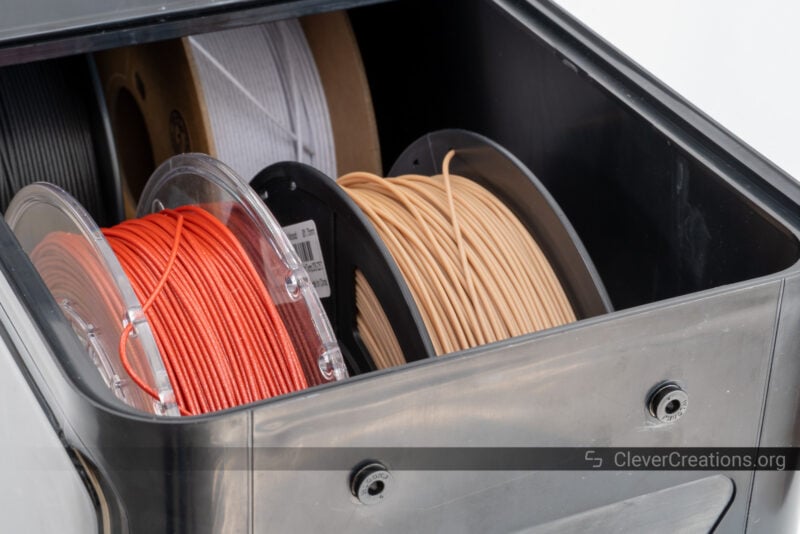
Wood is highly hygroscopic, i.e., it tends to absorb moisture quickly from the air. It leads to 3D printing difficulties like poor layer adhesion, weak prints, under extrusion, and blobs on the surface.
Hence, it’s crucial to store wood in dry places and away from moisture. The best way to store it is in zip-sealed bags with packets of silica gel in the bag. It’ll help to reduce the chances of filament absorbing moisture and retain the original material quality for a long time.
You can also use a dedicated filament dryer to store and dry your wood (PLA) filament before 3D printing. The one we currently use is the SUNLU FilaDryer S4 and we highly recommend it.
Can Wood PLA Be Sanded?

Certain wood-filled filaments like those from Hatchbox and SUNLU can be sanded easily. In fact, in some cases, sanding enhances the appearance and finish of your wooden 3D printed models.
With other wood filaments, like Polymaker’s PolyWood, the material is developed to mimic wood and doesn’t contain any actual bits of wood fiber. It’s a unique polymer blend that does not respond as well to sanding.
So if you’re primarily buying wood PLA filament intending to sand it, it’s a good idea to pick a wood filament brand that allows you to post-process it as you desire. The above recommendations, manufacturers recommendations, and user reviews are great resources that you can use to help you pick.
Is Wood PLA As Strong as PLA?
Wood filled filaments are usually weaker than real filaments. The wood fillers in the PLA plastic negatively affect the tensile strength, density, and durability of the material. As such, it’s not a good idea to use it for load-bearing parts or 3D printer components, no matter how good they look.
A study published in 2017 on “The effect of wood content in FDM filament on properties of 3D printed parts” indicates an inverse relationship between the wood content and strength in PLA material. It concludes that as the amount of wood filler in PLA filament increases, the material’s tensile strength decreases.
Another 2020 study on the fatigue behavior of PLA-wood composite manufactured by fused filament fabrication demonstrates similar results, concluding 3D printed wood PLA has relatively poor layer adhesion and less strength than regular PLA material.
Conclusion: Should You Use Wood Filament for Your 3D Printing Projects?
After making it through this entire article, you’ll have seen that wood PLA filament is a great material for adding a touch of rustic charm and natural beauty to your 3D printing projects. Its unique blend of wood fibers and polymers allows you to create stunning, wood-like textures and finishes that are perfect for a wide range of applications.
Not to mention, wood filament is a more sustainable and eco-friendly material than many other 3D printing plastics. Its variety is amazing too, with bamboo, pine, birch, walnut, rosewood, and other wood types right there for you to 3D print with.
Despite its compatibility with most 3D printers, there are some things to keep in mind when 3D printing wood filament. For example, the nozzle wear and clogging potential require you to be selective in the 3D printer nozzle you use.
Similarly, the propensity of wood filaments to cause stringing requires you to dial in the retraction settings before 3D printing your wood 3D printed models.
Once you have done that, however, we are sure that wood filaments will reward you plenty. Their ability to replicate the warmth and character of wood while maintaining the precision of 3D printing makes them a valuable addition to any maker’s toolkit.
If you’re ready to embark on your own wood filament journey or have any questions about this exciting material, we invite you to leave a comment below. Share your experiences, insights, or inquiries with us, and let’s continue to explore the boundless potential of wood filament together.
Happy printing!
